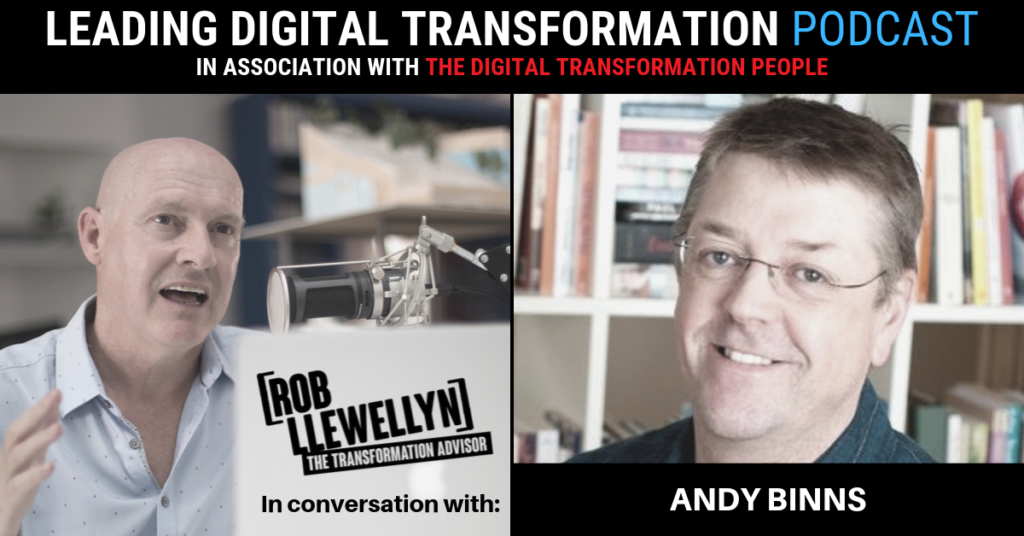‘Leading Digital Transformation’ is a weekly podcast series produced in collaboration between The Digital Transformation People and Rob Llewellyn digital transformation advisor and founder of CXO Transform.
During this series, Rob interviews experienced practitioners, authors and thought leaders whose stories and experiences provide valuable insights for digital transformation success.

In this episode, Rob speaks to Andrew Binns, executive fellow at the “Centre for the Future of Organization” at Drucker School of Management and the managing principal at Change Logic, a consultancy specialising in working with CEOs and senior leaders to help them manage and lead disruption in their markets.
Based on the research of their founding directors, Professors Michael Tushman (Harvard Business School) and Charles O’Reilly (Stanford GSB) Rob and his team apply a research-based methodology that gives firms a practical approach to leading change that both empowers teams and enables the cultural change required to be successful.
“If you’re a CEO or a senior team member you need to state an ambition, you need to have a sense of where you’re taking people and what it is that you want to create. Only then will your disruptive innovation activity make sense because it allows you to set some boundaries around what ideation you’re going to do and where you’re going to generate new ideas.”
Listen here and read the full transcript below.
Transcript
Rob Llewellyn [00:00:22] The threat of disruption from smaller more digitally-savvy firms has motivated many large corporates to launch efforts to build disruptors of their own. A few have succeeded, while many are wondering how to convert some great ideas into revenue-generating units. The difference between them is not the use of a single method or technique, but the ability to manage three distinct innovation disciplines known as ideation, incubation and scaling. My guest today is Andrew Binns. Andy is an executive fellow at the “Centre for the Future of Organization” at Drucker School of Management. Andy’s the managing principal at Change Logic. Research by Andy, Charles O’Reilly from Stanford and Mike Tushman from Harvard finds that most firms over emphasize ideation at the expense of the other two disciplines. Let’s jump into the interview with Andy to learn how to apply the three disciplines in an effort to accelerate the odds of success. Andy, welcome!
Andrew Binns [00:01:32] Hi Rob, nice to speak to you.
Rob Llewellyn [00:01:34] Great to have you here. Andy, what are the three disciplines that you talk about of innovation and why should managers pay attention to these?
Andrew Binns [00:01:45] Yeah, thanks Rob. So, we talk about the three disciplines of innovation in terms of disruptive innovation and these also apply to incremental doing better and better at your current business. But our main focus is how are you going to lead disruption, digital disruption, other types of disruption. So ideation is all about generating the new ideas, having fabulous insights, getting breakthrough thoughts, understanding customers’ needs, building empathy with them and finding ways in which you can serve those needs. So that’s ideation. But you’ve got to then figure out which are good ideas and that’s incubation – prove out whether your understanding of what the customer needs is accurate and whether you can develop a solution to meet those needs and whether they’ll pay for it. That’s incubation. And then Scaling is turning that proven idea into a revenue-generating business. Ideation, incubation, scaling. And what we find is that a lot of the action if you will in innovation is in the ideation space, and relatively little in the scaling, which is actually where the money is made. And so a lot of our point of view here is how do you rebalance our attention, our effort, our understanding of what businesses need to do so that more can be successful at leading disruption.
Rob Llewellyn [00:03:10] Andy, why do you think firms are perhaps overly focussed on ideation and not giving due care and attention to scaling and possibly incubation?
Andrew Binns [00:03:23] You know, Rob, I think that it’s possible my answer might sound a little cynical. I don’t mean it to be, but I think it’s easier I think in a fundamental way that’s less at risk to an existing corporation and I’m talking here about existing companies rather than the Start-Up space, and ideation is high energy, it can be highly participative, it creates a sense of inclusion and optimism inside an organization. But you don’t necessarily have to do anything with it. And so this generation of ideas becomes something that is seen as cultural intervention as well as an innovation thing. But the consequences come when you have to commit resources and maybe engage with customers and so on. And that’s later in the process. So the skew towards ideation I think is because it’s easier, it has this opportunity to shift culture and it doesn’t have the consequences. But there’s also a positive side, and the positive side is that many firms struggle with how they get insights outside-in to their business. So this is part of where ideation’s value really has come, is our focus on techniques like design thinking and so on or open innovation have brought more outside-in thinking to corporation. So, even as my cynical side says there are these negative reasons for the focus, there’s also some positives that ideation needs to bring to many established companies.
Rob Llewellyn [00:04:53] So we see a lot of firms now embracing ideation. It’s great for the workforce. It’s great for the culture, but we’ve got these other two areas which you’ve said that organizations also need to be focussed on. Are some firms better at these other disciplines and ideation than others?
Andrew Binns [00:05:14] Yeah, for sure. I think that there is good evidence that there are firms that are making a real focus on how to get better at it incubation for sure, and I think here we have to give a lot of credit to the whole Lean start-up movement, which has taught us something about how we think about doing incubation or doing business experiments, if you will, that this test-and-learn iteration of different aspects of a business proposition and business model has given us a sort of a language and an approach. The whole notion of MVPs and so on. So, I think there are a lot of firms who have made their commitments and have benefited from it. My work started with IBM twenty years ago working on this area, and IBM at that point had a pretty disciplined method for learning how to do this experimentation thing. But I think that the Lean start-up movement has made that even more rigorous than we had at IBM twenty years ago. So, we see firms in financial services – ING I think is working on this – Bosch is another firm that I know has a very good approach to incubation and Relx, a media firm that many people may not know, has been very successful at proving out different businesses and then scaling them. So, there are a number of firms that are good role models in this area.
Rob Llewellyn [00:06:39] Andy, it might seem obvious to some people, but can you spell out what the consequences could be of spending too much time on ideation and not enough time and resource in incubation and scaling?
Andrew Binns [00:06:51] So part of the consequence is that you don’t get anywhere, you don’t generate any revenue, you don’t generate anything really disruptive, you generate activity rather than outcomes. Another way that this plays out is you generate what I call the “innovation zoo”. There are lots of little ideas underfunded and unable to get attention. And this over time builds a sort of cynicism about whether we’re really going to invest in the future or not. And so the innovation zoo is a set of people all running after nicely generated ideas but with no real sense as to how resources are going to get allocated both to do the experimentation or, more importantly, to do the scaling. And so when we’re invited into firms, we’re often faced with exactly that problem. How do we turn these many, many little ideas into a few that are going to be successful?
Rob Llewellyn [00:07:50] Now innovation, Andy, as with transformation, is about creating a new future. But of course that’s a risky business, particularly for incumbent organizations that have got a good past and they sometimes rest on their laurels a little bit too much. How can these large organizations overcome the risk aversion that seems to plague a lot of them?
Andrew Binns [00:08:11] Yeah, risk aversion is probably the most commonly cited problem when we all think about large corporations. I’ve worked in several before I became a consultant and the tendency to do things to the lowest common denominator, that pressure to make it less threatening to the current business more achievable in the short term, these pressures are ones that anybody who has had that experience really recognizes. And my own feeling is that this risk aversion is one pathology. The other pathology is “going big”, trying to break risk aversion by throwing a lot of money at something. So, let me give you an example of what I mean. If you think about what GE did with Predix and their move into the industrial Internet of Things, they bet big on Predix without really the evidence that there was a market or understanding what the market was for them. And ultimately, as it crashed and burned, it cost Jeff Immelt his job and their position in the Dow Jones. So it’s a good example of investing ahead of learning. So I would say risk aversion on one side is not investing enough to learn, and go big is investing ahead of your learning. So what we need to do is to get into position where we’re going to learn and invest at the speed of our learning. So to do that you’ve got to have a respect for generating hypotheses: we think this is a market, we think this is a customer need, actually having a point of view about a market, and then following the discipline of gathering evidence and respecting fact, and then being willing to learn and iterate what you’ve done. And that’s the cultural challenge about risk aversion: can you get into a position of stating hypotheses and following the facts, rather than being guided by the opinions or biases of a senior manager or even of a junior manager, it doesn’t really matter. The point is that you’ve got to come out of a world of bias and instinct and towards one of fact.
Rob Llewellyn [00:10:24] So Andy, in and out of different organizations, we see different senior leaders responsible or given the mandate to own innovation, do you see a lot of them struggle to get those ideas, to get through the risk aversion and the barriers of executive management?
Andrew Binns [00:10:43] Yeah, I think my colleague in Change Logic is Professor Michael Tushman at the Harvard Business School. And Mike often says “exploit will always trump explore”, that the pressures of the day-to-day business will always be greater than the opportunity of the new. And it happens in lots of small ways. This is not often the case that somebody sets out deliberately with a malicious agenda to prevent the new businesses from being successful. It’s small things like I.T. rules, or H.R. policies or access to a particular customer. And so these many places where the existing business undermines the opportunity of the “explore” and really the only way out of this is that when you start to get into incubation, you’ve got to separate out the disruptive innovations from the core business. You’ve got to have some kind of way of giving them protection, autonomy from the day-to-day business, otherwise exploit will trump explore every time.
Rob Llewellyn [00:11:53] Andy, why is scaling so challenging and what can companies do about it?
Andrew Binns [00:11:59] Yeah, that’s the big question. And part of it is what I just said, this question of the pressures, the inertia of the existing business, Rob. The other part of this is: how do you go through this? We believe strongly that there is an importance around ambition. You need to know what it is you’re trying to disrupt first. What do you want to be famous for, where do you want to be in? And here I would use an example of Nvidia and Jensen Huang at Nvidia, which is a semiconductor company that we previously thought of as only generating images on a computer screen, graphic processing units for computers. Now, they’re at the centre of artificial intelligence for a scientific discovery, for bitcoin processing and for autonomous driving. And Jensen was very deliberate in how he got here. He said: “We want to create new end markets for our business. We want to solve problems that only we can solve and that nobody else is attacking.” And he deliberately went after these big issues of artificial intelligence in these different domains. And so his ambition firstly drove him. Then if you have that ambition, you are going to be ideating and incubating towards that goal. And so you have some guide rails, you have some way of knowing “what are we heading towards? What’s our hypothesis about our future?” That I think anchors you tremendously in the right set of steps towards scaling, so that when things go wrong, you still know where you’re headed. The next thing is you need a path. You need to then say what are the two, three, four steps I’m going to put in place in order to get to the scaled endpoint. And that’s going to be something to do with “what capabilities do I need? What customers do I need? What end customer access do I need? And what capacity do I need? What places will I need to be stronger than I am today?” And if you can build a path towards your ambition, capacities, capabilities, customers, and make decisions: some things you’re going to buy, some things you’re going to build, and make a choice how you assemble your different assets towards that ambition. So this is for us the secret scaling: ambition, clarity on the path and then this point about separating out your units so that they have the autonomy to be able to act at speed.
Rob Llewellyn [00:14:24] Now, Andy, you’ve already mentioned a couple of firms that are doing innovation well. What are the firms which are really the tremendous role models that others can look up to and what kind of things can they learn from them, because I think most organizations out there have good intentions, they have big aspirations to be innovative, but it’s difficult. So where can they get their guidance from?
Andrew Binns [00:14:51] It’s a very fair question. I think there are many good role models out there. I actually think Microsoft under Satya Nadella has turned a corner in respect of this, partly because they have let go of the rules that held them back. They were so wedded to Windows, [in that] everything has to work on Windows and as soon as Nadella takes away this rule and says “you tell me how we can serve end-customer needs and use all of our assets to do that”, they were able to move at a much faster pace. And I think what they’ve done with Windows Office 365 is pretty special as well. And they did that in many of the ways that I’ve already described in terms of separating out responsibility for offices, a desktop and office online. So I think Microsoft are a pretty interesting firm. I also think this firm Relx and it has a couple of different business units that are very interesting. People may have heard of LexisNexis which was an elite which is a legal information service. And LexisNexis has itself reinvented different digital tools, different ways to do things like predicting legal outcomes using big data. But the real story of LexisNexis is that over the last 20 years, it’s been able to build a business which is larger than itself. LexisNexis Legal is one, one and a half or slightly more billion of revenue each year. LexisNexis Risk, which came from within LexisNexis, is two point one billion of revenue. And this is a big data story, a digital transformation and they have done this with a very deliberate approach of testing and learning their way to this new business. They did it with some acquisitions, but they didn’t do it with the sense of buying a whole acquisition, “oh we’ll add that revenue to ours”. What they did is they had this sense of “what are the different moves we need to make in order to create a big data business that will be a platform for insurance companies and for law enforcement and for others?”. This was something that they saw and they tested and learned their way towards it in a very deliberate way. So I think those are some of the sorts of role models that I look to, in terms of firms that are really innovating.
Rob Llewellyn [00:17:07] Andy, I’d like to refer back to a very well-known quote now, which came from George Westerman quite a few years ago, and George said “when digital transformation is done correctly, it’s like a caterpillar turning into a butterfly, but when done wrong, all you have is a really fast caterpillar”. Now, the reason I ask you this question – and we all know this one, and I think most people listening to the podcast know that one – but we’re talking about innovation here. Tell us why is innovation so critical and so connected with those words that George spoke all those years ago?
Andrew Binns [00:17:42] That is a great quote and it’s in many ways it’s this difference between incremental and disruptive innovation. Are you going to simply add capabilities to your existing caterpillar or are you going to experiment with the aerodynamic possibilities of wings? And if you’re going to experiment with the aerodynamic possibilities of wings, then you’re going to need to work outside of the dominant norms and the sets of ideas that you would have within the caterpillar world. And so for me this ideation-incubation-scaling is fundamental and I would recommend it to caterpillars everywhere. I think it’s the right way to go.
Rob Llewellyn [00:18:25] Andy, we started the conversation with you describing the three disciplines of innovation, ideation incubation and scaling. So tell us, what do firms need to do to get better at these three disciplines?
Andrew Binns [00:18:41] Yes, so firstly, I think this question of ambition is central and it’s the job of senior leaders. One of my difficulties with this whole space often is people within a company with innovation managers who may be listening to this podcast that only the senior leaders would do X, Y and Z. And often I don’t think that’s true, as I think that’s too easy an answer. But in this case, it’s the only answer. If you’re a CEO or a senior team member you need to state an ambition. You need to have a sense of where you’re taking people, what it is that you want to create. And only when you have that does your innovation, your disruptive innovation activity, make sense, because that allows you to have some boundaries around what ideation you’re going to do, where you’re going to generate new ideas. Otherwise, you risk this “innovation zoo” where there’s ideas all over the place. So ambition, use that to set some boundaries around where you’re headed and then be systematic in how you do your incubation using experimentation. And then when it comes to scaling, separate it out. Don’t leave it with the core business to do, it will always struggle when it’s within the existing business, it’s very difficult to challenge and recreate things from within. So that’s our – from the work we’ve done at Change Logic, that’s what we find to be most vital and there are some really good case studies to explain why that matters so much. One of the ones that Mike Tushman has done an excellent case study on is the French advertising firm Havas who really went down the road of digital innovation trying to replace the creatives within the advertising agency with CrowdSource, creative innovation, leading it out to a crowd to generate ideas for ad campaigns and so on. And he has this marvellous video of the Chief Operating Officer of the business and he says: “Well that might work, but it’s really like a hundred monkeys: once in a while they’ll come up with Hamlet”. And in that moment, he deflates the very premise of the innovation that they spent a lot of money developing. And so, that’s the pressure of the dominant norms of the existing business will always undermine your efforts unless you figure out how to separate it out when it comes to incubation and scaling. And this notion of running an ambidextrous business that is both excellent in its core and able to explore in new areas, that’s really the centre of all of this.
Rob Llewellyn [00:21:16] Andy, we’re up against time. So listen, where can people go to learn more about what you’ve been telling us about today?
Andrew Binns [00:21:26] So Change Logic has a website: www.Change-Logic.com. You can read some of our stuff at The Digital Transformation People. Michael and his Stanford colleague Charles [O’Reilly] have written a book called “Lead and Disrupt” and www.leadanddisrupt.com is another website where you can get details on that book.
Rob Llewellyn [00:21:46] Terrific. We’ll put links to those in the show notes. Andy, thank you so much for taking the time to speak with us today.
Andrew Binns [00:21:53] Thank you, Rob, for the invitation. I enjoyed it.
Announcer: [00:21:55] We hope you enjoyed this episode of “Leading Digital Transformation” with Rob Llewellyn and The Digital Transformation People. Visit www.thedigitaltransformationpeople.com to secure the knowledge, talent and services you need for digital transformation success. To continue your journey as a certified transformation professional, visit www.RobLlewellyn.com. Be sure to subscribe to the podcast and follow us on Twitter @TheDigitalTP and @RobertLlewellyn
Article by channel:
Everything you need to know about Digital Transformation
The best articles, news and events direct to your inbox
Read more articles tagged: Featured, Innovation









